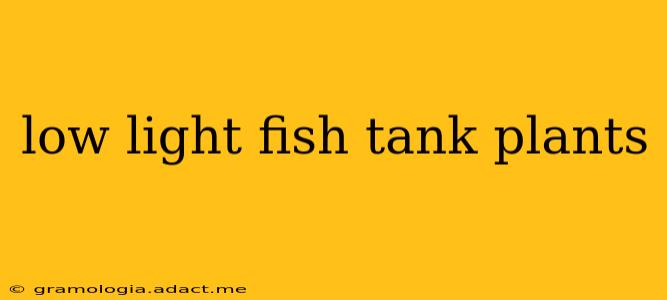Maintaining a vibrant and healthy aquarium can be challenging, especially when dealing with low-light conditions. Many beautiful aquatic plants require intense lighting to flourish, but thankfully, several hardy species thrive even in dimly lit tanks. This guide explores the best low-light fish tank plants, offering tips for successful cultivation and answering frequently asked questions.
What are the best low-light aquarium plants?
Choosing the right plants for your low-light aquarium is crucial. Some excellent options include:
-
Java Moss (Taxiphyllum barbieri): This incredibly adaptable plant grows well attached to rocks, driftwood, or even the substrate. It requires minimal care and tolerates a wide range of water parameters. Java moss is a fantastic choice for beginners.
-
Anubias Nana: Known for its resilience and slow growth, Anubias Nana is another excellent option for low-light aquariums. It prefers to be attached to hardscape rather than planted in the substrate to prevent root rot.
-
Java Fern (Microsorum pteropus): Similar to Anubias Nana, Java Fern is low-maintenance and thrives in low-light conditions. Its broad, elegant leaves add a touch of sophistication to any aquarium. Again, attach it to hardscape rather than planting in the substrate.
-
Amazon Sword Plant (Echinodorus amazonicus): While it appreciates brighter light for optimal growth, the Amazon Sword Plant can surprisingly adapt to low-light conditions, albeit with slower growth. This plant provides a stunning backdrop for your aquarium.
-
Cryptocoryne species (e.g., Cryptocoryne wendtii): Many Cryptocoryne varieties are tolerant of low-light environments. They offer a variety of leaf shapes and colors to add visual interest.
These plants are known for their hardiness and ability to thrive even with minimal lighting. However, even these low-light plants will benefit from some light, albeit less intense than plants needing high light conditions.
How much light do low-light plants need?
The term "low-light" is relative. While these plants don't need the intense lighting of high-light species, they still require some light for photosynthesis. Aim for 4-6 hours of indirect or low-intensity artificial light per day. Avoid direct sunlight, which can cause algae blooms.
What are the signs of insufficient light for my low-light aquarium plants?
If your low-light plants aren't thriving, several signs might indicate insufficient light:
- Stunted growth: Plants are growing very slowly or not at all.
- Pale or discolored leaves: Leaves may appear yellow or lack vibrant green color.
- Leaf melting: Older leaves may start to decay and melt away.
- Algea overgrowth: While some algae are natural, excessive algae growth can indicate an imbalance, often linked to inadequate light for plant growth leading to less nutrient uptake.
Can I use LED lights for low-light aquarium plants?
Yes, LEDs are an excellent choice for low-light aquariums. LEDs offer energy efficiency, long lifespan, and precise control over light intensity and spectrum. Choose LEDs designed for aquariums and select a lower intensity setting appropriate for low-light plants.
What type of substrate is best for low-light plants?
A nutrient-rich substrate is beneficial for all aquarium plants, even those thriving in low-light conditions. Consider a substrate enriched with plant fertilizers to promote healthy root development and overall plant health.
How often should I fertilize low-light aquarium plants?
While low-light plants have lower nutrient requirements than high-light plants, fertilization is still essential for optimal growth. Use a liquid fertilizer specifically designed for aquarium plants and follow the manufacturer's instructions. Less frequent fertilization may be necessary compared to high-light plants.
Can I mix low-light and high-light plants in the same tank?
While possible, it's generally not recommended to mix low-light and high-light plants in the same tank unless you have a very carefully planned lighting system. High-light plants will likely struggle in the low-light conditions, and the low-light plants might not get enough light to thrive.
By selecting the right plants and providing appropriate care, you can create a beautiful and thriving low-light aquarium. Remember, even low-light plants need some light, consistent water parameters, and occasional fertilization to flourish. With a little patience and attention, you can enjoy a stunning underwater landscape even without intense lighting.
